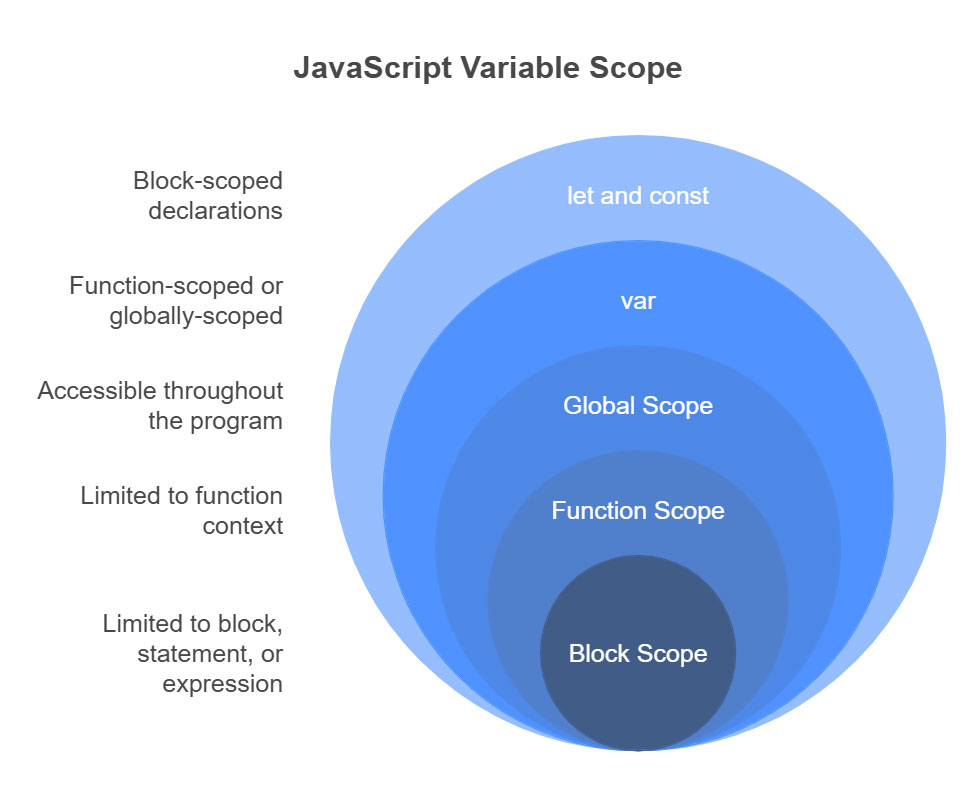Variables represent a core principle in programming, and JavaScript is no different. Mastering the effective use of variables is crucial for producing clean and efficient code. This blog will provide an in-depth examination of JavaScript variables, emphasizing the three primary methods of declaration: var, let, and const. By the conclusion of this article, you will possess a comprehensive understanding of their distinctions and the appropriate contexts for utilizing each.
What Are JavaScript Variables?
In JavaScript, a variable functions as a storage unit for data. It can be likened to a labeled box that allows for the storage and retrieval of values. Variables serve the purpose of holding various types of information, including numbers, strings, objects, or even functions, which can be utilized multiple times within your program.
For example:
let name = "John";
console.log(name); // Outputs: JohnIn this example, the variable name holds the value “John.” You can later update or access this value in your code.
Variables are essential because they allow us to:
- Store dynamic data that changes during program execution.
- Write reusable and maintainable code by referencing values with meaningful names.
- Enhance readability and debugging by avoiding hardcoded values.
The Evolution of JavaScript Variables
JavaScript has undergone significant changes over the years, particularly in the methods used for variable declaration. Initially, the only keyword available for this purpose was var. However, with the advent of ES6 (ECMAScript 2015), two additional keywords, let and const, were introduced for variable declaration.
Below is a summary of each keyword:
var: This is the original keyword for declaring variables in JavaScript, but it comes with certain quirks and limitations.
let: Introduced in ES6, this keyword offers greater flexibility and resolves many of the issues associated with Var.
const: Also introduced in ES6, this keyword is intended for variables that are not meant to be reassigned.
Now, let us explore each of these keywords in greater detail.
var: The Traditional Way
The var keyword has been a fundamental part of JavaScript since its inception. Although it remains supported, its use is generally discouraged in contemporary development due to certain idiosyncrasies.
Key characteristics of var include:
- Function Scope: Variables defined with var are limited to the nearest function scope. Consequently, they can be accessed throughout the function in which they are declared, but not from outside that function.
- Hoisting: Declarations made with var are hoisted to the top of their respective scope. This allows for referencing the variable prior to its declaration, although its value will be undefined until it is explicitly assigned.
- Re-declaration: It is possible to declare the same variable multiple times without encountering errors, which may inadvertently result in data being overwritten.
Example:
function example() {
console.log(a); // Undefined (due to hoisting)
var a = 10;
console.log(a); // 10
}
example();In this instance, the declaration of the variable ‘a’ is elevated to the beginning of the function; however, its value remains undefined until the assignment operation is performed.
Drawbacks of using var:
- Global Pollution: Variables declared with var in the global context become attributes of the window object, which may inadvertently overwrite pre-existing properties.
- Absence of Block Scope: Due to the fact that var is not confined to block scope, it can result in unforeseen behavior within loops and conditional statements.
if (true) {
var x = 5;
}
console.log(x); // 5 (accessible outside the block)Why avoid var?
The characteristics of function scoping and the capacity to re-declare variables may result in errors and misunderstandings, particularly within extensive codebases.
let: The Modern Replacement for var
The let keyword was introduced to enhance the process of variable declaration, addressing numerous issues that arise with the var keyword.
Key features of let include:
- Block Scope: Variables defined using let are limited to the nearest enclosing block (e.g., {…}), which can include loops, conditionals, or functions. This allows for improved management of variable visibility.
- Hoisting with Temporal Dead Zone (TDZ): Although let declarations are hoisted, they exist in a “temporal dead zone” from the beginning of the block until the variable is both declared and initialized. Attempting to access the variable prior to its declaration will result in a ReferenceError.
- No Re-declaration: In contrast to var, it is not permissible to declare a let variable with the same name within the same scope.
Example:
if (true) {
let x = 10;
console.log(x); // 10
}
console.log(x); // Error: x is not definedIn this example, x is only accessible within the block where it is defined.
Why use let?
The block-scoping characteristic of the let keyword enhances the predictability of your code and reduces the likelihood of errors. It is the recommended option for variables that require reassignment.
const : For Constants
The const keyword serves to declare variables that are not intended to be reassigned following their initial assignment. It is particularly suitable for values that remain unchanged throughout the execution of your program.
Attributes of const:
Block Scope: Similar to let, const is confined to the block in which it is declared.
Immutable References: While the reference of the variable cannot be reassigned, if it references an object or an array, the elements within that object or array may still be altered.
Mandatory Initialization: A value must be assigned to a const variable at the moment of its declaration; failing to do so will result in a syntax error.
Example:
const PI = 3.14;
console.log(PI); // 3.14
PI = 3.14159; // Error: Assignment to constant variable
const numbers = [1, 2, 3];
numbers.push(4);
console.log(numbers); // [1, 2, 3, 4]In this example, the value of PI cannot be reassigned, but the contents of the numbers array can be modified.
Why use const?
Using const makes your code more predictable by clearly indicating which variables should not be reassigned. It is especially useful for constants, configurations, and values that shouldn’t change over time.

Comparing var, let, and const
Here’s a detailed comparison of the three ways to declare variables:
| Feature | var | let | const |
|---|---|---|---|
| Scope | Function | Block | Block |
| Hoisting | Yes | Yes (TDZ applies) | Yes (TDZ applies) |
| Re-declaration | Allowed | Not allowed | Not allowed |
| Reassignment | Allowed | Allowed | Not allowed |
| Initialization | Optional | Optional | Mandatory |
Practical Example:
function testVariables() {
if (true) {
var a = 1;
let b = 2;
const c = 3;
}
console.log(a); // 1 (function-scoped)
console.log(b); // Error: b is not defined (block-scoped)
console.log(c); // Error: c is not defined (block-scoped)
}
testVariables();This example highlights the scope differences between var, let, and const.
Best Practices for Using JavaScript Variables
- Default to Using const: Opt for const as the standard practice unless it is clear that the variable will require reassignment.
- Utilize let for Variables That Change: When a variable’s value is expected to change, employ let.
- Refrain from Using var: In contemporary JavaScript, there is minimal justification for utilizing var.
- Limit Scope: Declare variables within the smallest necessary scope to prevent unintended alterations.
- Select Meaningful Names: Use descriptive names for variables to improve the readability and maintainability of your code.
- Consolidate Declarations: Position variable declarations at the start of their respective scope to enhance clarity.
- Employ Constants for Configuration Settings: Use const to define constant values (such as API endpoints and thresholds) to prevent unintentional modifications.
Final Thoughts.
Grasping the distinctions between var, let, and const is essential for crafting effective JavaScript code. Although var was adequate in the early stages of JavaScript, the advent of let and const has facilitated the creation of safer and more predictable code. By employing const for immutable variables and let for those that are subject to change, you can guarantee that your code remains clean, efficient, and comprehensible.
Achieving proficiency in these variable declarations will enable you to produce modern JavaScript code that is both dependable and easy to maintain. When you next engage in JavaScript programming, be sure to select the appropriate variable declaration according to your requirements. Wishing you successful coding!
Resources:









